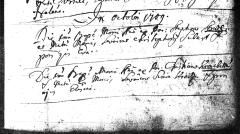This register is from the Roman Catholic Church of Szent Mihály in the city of Sopron. The earliest records of this church date back to 1652.
 for more information on early Sopron records. Two records are shown to illustrate differences in legibility, abbreviations, and terminology -- yet, both contain the same minimal information in Latin narrative. This example is aimed at providing a comprehensive picture of early Latin-language baptism records.
for more information on early Sopron records. Two records are shown to illustrate differences in legibility, abbreviations, and terminology -- yet, both contain the same minimal information in Latin narrative. This example is aimed at providing a comprehensive picture of early Latin-language baptism records.
Content of Register.
We see in the 1709 example two entries from the bottom of a page in this register. Both are structured identically, as are most of the records surrounding them, even though the handwriting indicates different scribes were involved. The entries are written in Latin, using fairly normal Roman cursive script, and so are reasonably decipherable if you understand that many words are abbreviated. The 1716 example, found several pages later in the same church register, is more legible, uses fewer abbreviations and slightly differing terminology -- but, contains exactly the same information.
 for a discussion of the abbreviations in these entries.
for a discussion of the abbreviations in these entries.
Month Header: Notice that in the 1709 record,a header is seen for the month -- in this case "In October 1709".  for more information.
for more information.
Each of the records shown consists of the following:
- Date: Both 1709 entries read Die 1'ma or the first day of the month -- here October. The 1716 entry reads Die 22 April or the 22nd day of April -- so the month is given redundantly. In both it is followed by is baptized -- in 1709 using the abbreviation Bap e' and in 1716 spelled out as baptizimus est. Though this is not the case with these examples, some entries will have at this point the words infans nomine, meaning a baby named.
- Child's Given Name(s): Most Hungarians were given only one name. Multiple names tended to be used only by wealthier or more prominent families. But, Roman Catholics were always more likely to use multiple given names than Protestants. The names of my relatives baptized here are given in Latin as Mari Ańa (1709) and Joannes georgius (1716). But, in my database I use standard Magyar spellings of all given names, ie. Mária Anna and János György.
- Full Name of Father: Though again not found in these examples, some entries at this point will identify the sex and status of the child. For instance filia legitima meaning legitimate daughter of. Here the term ex Parentes or from (ie. out of) the parents is used, and then the father's full name is provided. Since these entries are in Latin, the given name is usually Latinized and comes first. The family name is almost never Latinized, so the ethnicity -- Magyar, German, Slovak, etc may be apparent.
- Given Name of Mother: In the case of legitimate births, the mother's name is usually introduced by: et uxoremeaning and his wife as in the 1716 entry. The 1709 entry uses a undecipherable (by me) abbreviation that may be et sponsa (and his bride) or et conjux (and his spouse). Then the mother's given name is provided. In this early period, it is quite rare that the maiden name of the mother is specified here, although later it was virtually always given.
 for the story of how I identified the maiden name of this mother.
for the story of how I identified the maiden name of this mother.
- Names of Sponsors (ie. Godparents): This entry is usually introduced by either of the two most common Latin expressions for Godparents: Levantes or Patrini. Then the name of the godfather is given, followed usually by cum uxore meaning with his wife and the wife's given name. If the godmother is not the wife of the godfather (common alternatives are a significantly older sister of the baby, or a maiden aunt), she will likely be introduced by et virgine meaning and the maiden. A single man as godfather would be introduced as a coelebs. Various other alternatives are possible, but unusual. In this early period a single set of godparents was typical. Later, multiple godparents were often used, especially in Protestant baptisms.
Read the final entry on the 1709 page as: "On the first day of the month, Maria Anna is baptized, from the parents Christian Kronebetter and his bride Eva Maria. Godparents were Simon Kraszér and his wife Elesina."
Read the 1716 entry as: "On the 22nd day of April, John George was baptized, from the parents Christian Kronawöther and his wife Eva Maria. Godparents were the nobleman Simon Kraszér with his wife Elesina."
Note the spelling discrepancy in the family name between the two entries, which very obviously refer to the same family.  for a brief discussion of the spelling issues involved here.
for a brief discussion of the spelling issues involved here.





